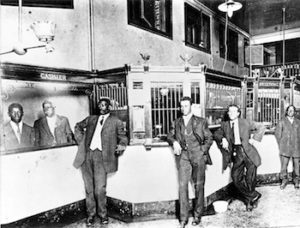
Ala. Penny Savings lobby
*This date in 1890 celebrates the founding of Alabama Penny Savings Bank. It was Alabama’s first bank for Blacks, one of the first for Blacks in America.
Founded by William Pettiford in 1902, the deposits were $78,124.21; by 1911, they had reached $421,596.51. Much of the bank's success resulted from his and the directors' emphasis on homeownership. Records show that the Penny Bank was the leading mortgage to persons buying homes in Smithfield, Birmingham's most prominent Black community. In addition, during the bank's first decade, Pettiford and other officials engineered many real estate transactions that proved highly lucrative.
In 1913, the Penny Bank constructed its building on Eighteenth Street in Birmingham's thriving business district. The five-story building had 64 rooms and housed other Black businesses on its upper floors. Businesses occupied all of them except one, paying the Penny Savings Bank a total of $8,000 in rent.
The building represented a tangible demonstration of the director's self-help and economic solidarity philosophy: Blacks cooperating to assist other Blacks. Windham Construction, a Black-owned company, built it. The style of the building suggested the architectural touch of Wallace A. Rayfield. Without this strong bank, most homes for Birmingham’s earliest Blacks would never have been built. The building also housed the city's earliest Black doctors and attorneys.
In 1915, the bank closed, and the Grand Lodge Knights of Pythias, a Black fraternal organization, bought the building. It has been known as the Pythian Building since then. It is on the National Register of Historic Places, 310 18th Street North, Birmingham.